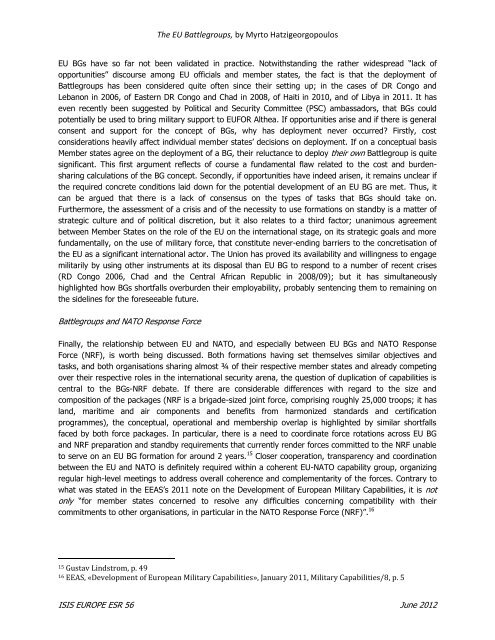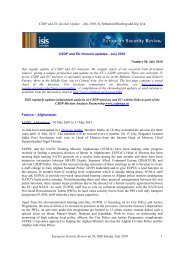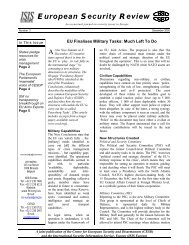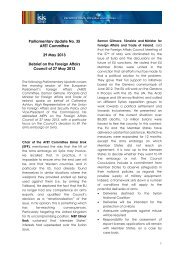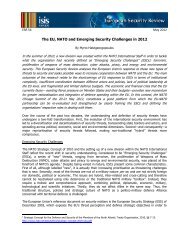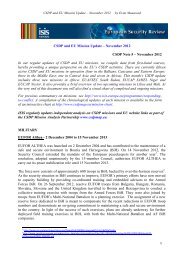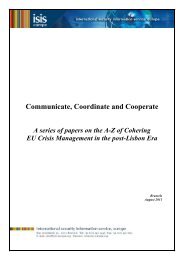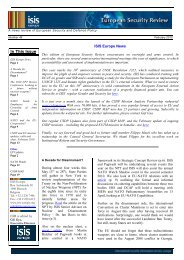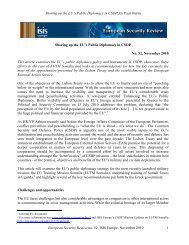the role of eu battlegroups for european defence - ISIS Europe
the role of eu battlegroups for european defence - ISIS Europe
the role of eu battlegroups for european defence - ISIS Europe
You also want an ePaper? Increase the reach of your titles
YUMPU automatically turns print PDFs into web optimized ePapers that Google loves.
The EU Battlegroups, by Myrto Hatzigeorgopoulos<br />
EU BGs have so far not been validated in practice. Notwithstanding <strong>the</strong> ra<strong>the</strong>r widespread “lack <strong>of</strong><br />
opportunities” discourse among EU <strong>of</strong>ficials and member states, <strong>the</strong> fact is that <strong>the</strong> deployment <strong>of</strong><br />
Battlegroups has been considered quite <strong>of</strong>ten since <strong>the</strong>ir setting up; in <strong>the</strong> cases <strong>of</strong> DR Congo and<br />
Lebanon in 2006, <strong>of</strong> Eastern DR Congo and Chad in 2008, <strong>of</strong> Haiti in 2010, and <strong>of</strong> Libya in 2011. It has<br />
even recently been suggested by Political and Security Committee (PSC) ambassadors, that BGs could<br />
potentially be used to bring military support to EUFOR Al<strong>the</strong>a. If opportunities arise and if <strong>the</strong>re is general<br />
consent and support <strong>for</strong> <strong>the</strong> concept <strong>of</strong> BGs, why has deployment never occurred? Firstly, cost<br />
considerations heavily affect individual member states’ decisions on deployment. If on a conceptual basis<br />
Member states agree on <strong>the</strong> deployment <strong>of</strong> a BG, <strong>the</strong>ir reluctance to deploy <strong>the</strong>ir own Battlegroup is quite<br />
significant. This first argument reflects <strong>of</strong> course a fundamental flaw related to <strong>the</strong> cost and burdensharing<br />
calculations <strong>of</strong> <strong>the</strong> BG concept. Secondly, if opportunities have indeed arisen, it remains unclear if<br />
<strong>the</strong> required concrete conditions laid down <strong>for</strong> <strong>the</strong> potential development <strong>of</strong> an EU BG are met. Thus, it<br />
can be argued that <strong>the</strong>re is a lack <strong>of</strong> consensus on <strong>the</strong> types <strong>of</strong> tasks that BGs should take on.<br />
Fur<strong>the</strong>rmore, <strong>the</strong> assessment <strong>of</strong> a crisis and <strong>of</strong> <strong>the</strong> necessity to use <strong>for</strong>mations on standby is a matter <strong>of</strong><br />
strategic culture and <strong>of</strong> political discretion, but it also relates to a third factor; unanimous agreement<br />
between Member States on <strong>the</strong> <strong>role</strong> <strong>of</strong> <strong>the</strong> EU on <strong>the</strong> international stage, on its strategic goals and more<br />
fundamentally, on <strong>the</strong> use <strong>of</strong> military <strong>for</strong>ce, that constitute never-ending barriers to <strong>the</strong> concretisation <strong>of</strong><br />
<strong>the</strong> EU as a significant international actor. The Union has proved its availability and willingness to engage<br />
militarily by using o<strong>the</strong>r instruments at its disposal than EU BG to respond to a number <strong>of</strong> recent crises<br />
(RD Congo 2006, Chad and <strong>the</strong> Central African Republic in 2008/09); but it has simultaneously<br />
highlighted how BGs shortfalls overburden <strong>the</strong>ir employability, probably sentencing <strong>the</strong>m to remaining on<br />
<strong>the</strong> sidelines <strong>for</strong> <strong>the</strong> <strong>for</strong>eseeable future.<br />
Battlegroups and NATO Response Force<br />
Finally, <strong>the</strong> relationship between EU and NATO, and especially between EU BGs and NATO Response<br />
Force (NRF), is worth being discussed. Both <strong>for</strong>mations having set <strong>the</strong>mselves similar objectives and<br />
tasks, and both organisations sharing almost ¾ <strong>of</strong> <strong>the</strong>ir respective member states and already competing<br />
over <strong>the</strong>ir respective <strong>role</strong>s in <strong>the</strong> international security arena, <strong>the</strong> question <strong>of</strong> duplication <strong>of</strong> capabilities is<br />
central to <strong>the</strong> BGs-NRF debate. If <strong>the</strong>re are considerable differences with regard to <strong>the</strong> size and<br />
composition <strong>of</strong> <strong>the</strong> packages (NRF is a brigade-sized joint <strong>for</strong>ce, comprising roughly 25,000 troops; it has<br />
land, maritime and air components and benefits from harmonized standards and certification<br />
programmes), <strong>the</strong> conceptual, operational and membership overlap is highlighted by similar shortfalls<br />
faced by both <strong>for</strong>ce packages. In particular, <strong>the</strong>re is a need to coordinate <strong>for</strong>ce rotations across EU BG<br />
and NRF preparation and standby requirements that currently render <strong>for</strong>ces committed to <strong>the</strong> NRF unable<br />
to serve on an EU BG <strong>for</strong>mation <strong>for</strong> around 2 years. 15 Closer cooperation, transparency and coordination<br />
between <strong>the</strong> EU and NATO is definitely required within a coherent EU-NATO capability group, organizing<br />
regular high-level meetings to address overall coherence and complementarity <strong>of</strong> <strong>the</strong> <strong>for</strong>ces. Contrary to<br />
what was stated in <strong>the</strong> EEAS’s 2011 note on <strong>the</strong> Development <strong>of</strong> <strong>Europe</strong>an Military Capabilities, it is not<br />
only “<strong>for</strong> member states concerned to resolve any difficulties concerning compatibility with <strong>the</strong>ir<br />
commitments to o<strong>the</strong>r organisations, in particular in <strong>the</strong> NATO Response Force (NRF)”. 16<br />
15 Gustav Lindstrom, p. 49<br />
16 EEAS, «Development <strong>of</strong> <strong>Europe</strong>an Military Capabilities», January 2011, Military Capabilities/8, p. 5<br />
<strong>ISIS</strong> EUROPE ESR 56 June 2012


